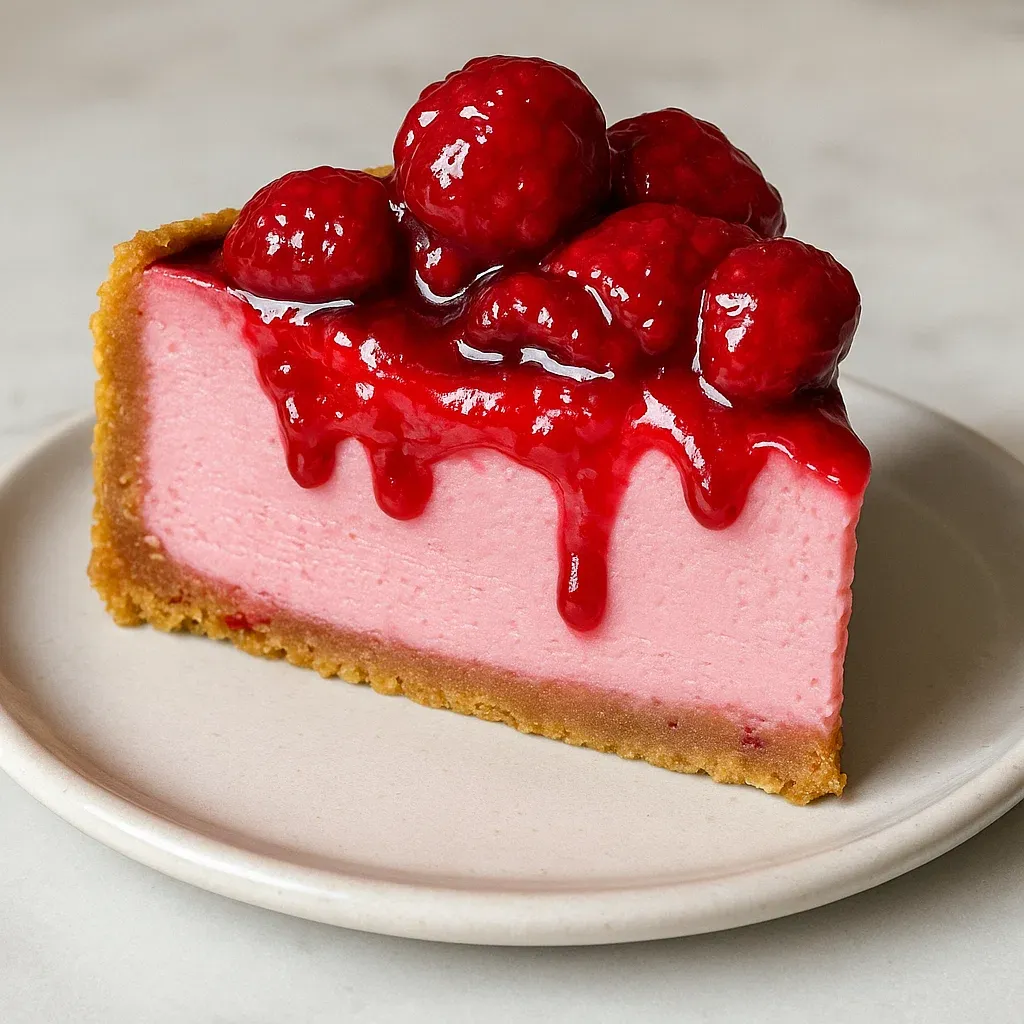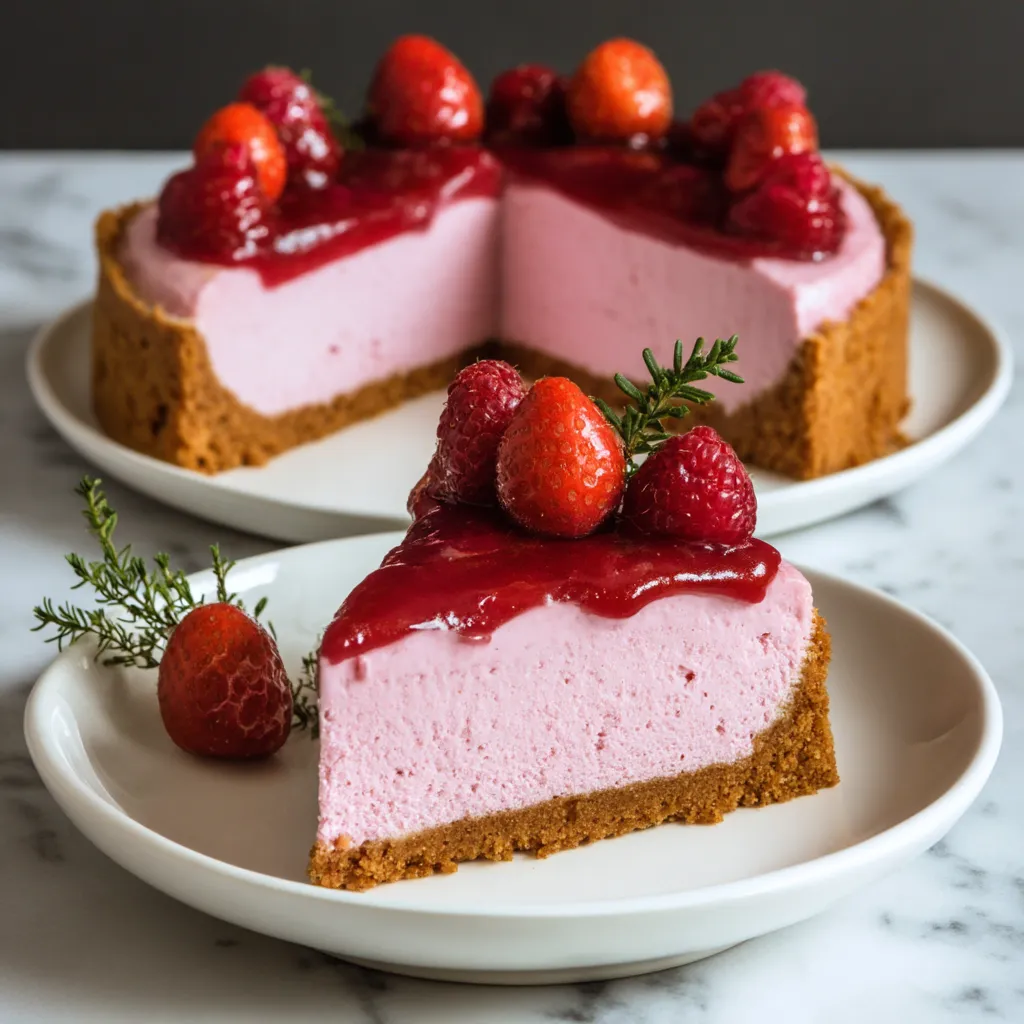 Pin it
Pin it
This hearty baked raspberry cheesecake has become my signature dessert for special occasions, delivering intense raspberry flavor in every bite. The creamy filling paired with the fresh raspberry sauce creates a perfect balance that keeps everyone asking for seconds.
I first developed this recipe when planning a dinner party for a friend with celiac disease. What started as an accommodation turned into the most requested dessert among my friends and family members of all dietary needs.
Ingredients
- Full fat cream cheese: gives this cheesecake its luxurious texture and rich flavor. Use room temperature blocks for the smoothest results.
- Fresh or frozen raspberries: work equally well in this recipe, making it accessible year round. The intensity of flavor after reduction is remarkable.
- Digestive biscuits: create the perfect sturdy yet tender base. Their subtle sweetness complements the tangy filling beautifully.
- Cornflour: stabilizes the cheesecake filling, preventing it from cracking without complicating the process with a water bath.
- Plain yogurt: adds a subtle tanginess that balances the sweetness while contributing to the creamy texture.
- Vanilla bean paste: provides tiny flecks of real vanilla and a depth of flavor that extract alone cannot achieve.
Step-by-Step Instructions
- Prepare the Crust:
- Crush digestive biscuits until they resemble fine sand with no large chunks remaining. Mix thoroughly with melted butter until the texture resembles wet sand that holds together when pressed. Press firmly into your springform pan using a flat bottomed glass to create an even layer with sides about 1.5 inches high. Bake for exactly 10 minutes at 350°F until slightly golden and fragrant.
- Create the Raspberry Reduction:
- Cook raspberries until completely broken down and juices are released. Strain carefully to remove all seeds for the smoothest texture. Return the vibrant red juice to the saucepan and reduce until thick and viscous, approximately 15 minutes of gentle simmering. The reduction should coat the back of a spoon and measure about half a cup when finished. This concentrated flavor forms the heart of your cheesecake.
- Mix the Filling:
- Combine room temperature cream cheese and yogurt using gentle folding motions rather than vigorous whisking. The goal is a smooth mixture without incorporating air that could cause cracks. Add sugar mixed with cornflour, then vanilla, focusing on thorough incorporation without overmixing. Add eggs one at a time, ensuring each disappears completely before adding the next. Finally, blend in the cooled raspberry reduction until achieving a uniform pink color.
- Bake with Patience:
- Pour the filling into your prepared crust and bake at a low 285°F for about 60 minutes. Look for set edges with a slight wobble in the center rather than relying solely on timing. Turn off the oven and leave the door slightly ajar, allowing the cheesecake to cool gradually to prevent cracks from temperature shock.
- Prepare the Sauce:
- Create a vibrant sauce by cooking raspberries with sugar until broken down, straining out seeds, and reducing to a syrupy consistency. Fold fresh raspberries into this reduction for a stunning topping that adds fresh flavor and visual appeal to each slice.
 Pin it
Pin it
The raspberry reduction is truly the secret weapon in this recipe. I discovered the technique while experimenting with ways to intensify fruit flavors without artificial additives. My niece actually called this the "most raspberry tasting thing that ever raspberried" at her birthday celebration last summer, which perfectly captures what makes this cheesecake special.
Perfect Temperature Matters
Room temperature ingredients are absolutely crucial for achieving that silky smooth texture in your cheesecake filling. When cream cheese is cold, it tends to form small lumps that never fully incorporate, no matter how long you mix. I recommend taking your cream cheese, yogurt, and eggs out of the refrigerator at least 2 hours before beginning. If you forget, you can carefully microwave the cream cheese in 10 second intervals, rotating the block each time, until it yields to gentle pressure but is not melted or warm.
Troubleshooting Common Issues
Cracks in your cheesecake typically stem from three main causes: overmixing the filling, baking at too high a temperature, or cooling too quickly. This recipe addresses all three problems. The gentle mixing method prevents excess air incorporation, the low baking temperature ensures even cooking, and the gradual cooling in the oven prevents the dramatic temperature change that causes the surface to split. If you do get small cracks, the raspberry sauce topping will beautifully conceal them while adding another layer of flavor.
Serving Suggestions
This raspberry cheesecake pairs wonderfully with a dollop of lightly whipped cream to balance the intensity of the fruit. For a more elaborate dessert table, serve alongside small glasses of champagne or prosecco, as the bubbles beautifully complement the rich creaminess. The cheesecake is substantial enough to serve 12 generous portions, making it perfect for gatherings. Consider garnishing individual plates with mint leaves or a light dusting of powdered sugar just before presenting to guests for an elegant final touch.
Frequently Asked Questions
- → Can I use frozen raspberries instead of fresh?
Yes, frozen raspberries work perfectly for both the filling and the sauce. Just ensure they are fully thawed before use.
- → How can I make this gluten-free?
Simply substitute the digestive biscuits with gluten-free cookies or biscuits of your choice for the crust.
- → Do I need a stand mixer to make the filling?
No, you can mix the filling by hand with a simple whisk or use a stand mixer on the lowest speed to avoid over-aerating the batter.
- → What is the best way to store the cheesecake?
Store the cheesecake in a closed container in the fridge for up to 4-5 days. Keep the raspberry sauce separate if possible to maintain its texture.
- → How can I tell when the cheesecake is done baking?
The edges should be set and slightly puffed, while the center should still be wobbly when you gently shake the pan.
